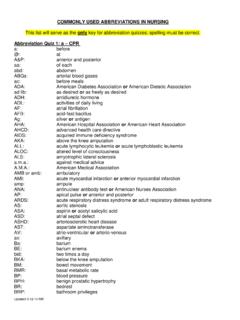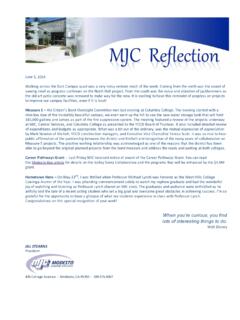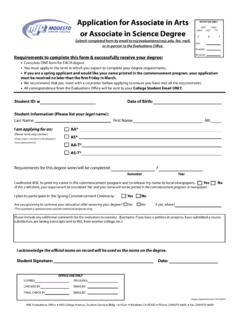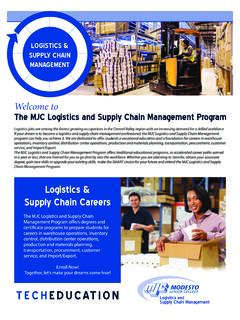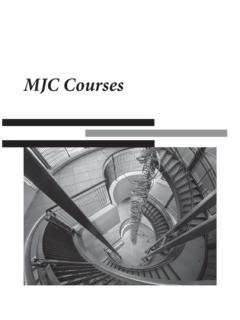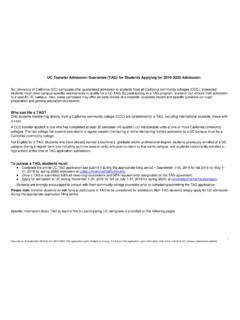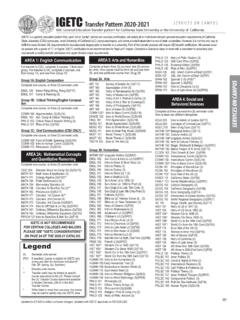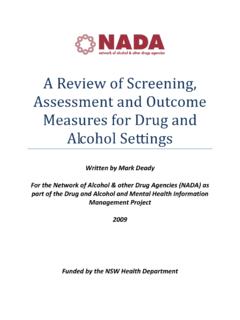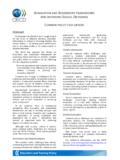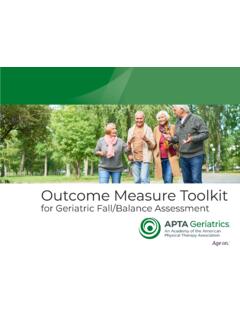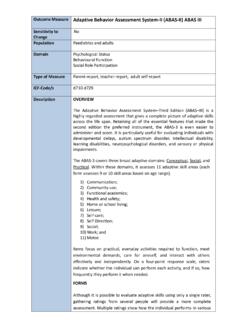Transcription of What is a Course Learning Outcome (CLO)?
1 10 | Page What is a Course Learning Outcome (CLO)? Course Learning outcomes are the big ideas, skills, or competencies students should be able to articulate, put into action, or utilize (theoretically or pragmatically) after their Course experience. As a general institutional practice, at MJC, the OAW has recommended that faculty construct 2-3 CLOs per Course . What is the difference between a Course objective and a Course Learning Outcome (CLO)? When faculty construct or adjust their curriculum, performing what is known as a Course outline of record update, part of the process includes affirming both the Course objectives and the Course Learning outcomes. Sometimes, the difference between objectives and outcomes can be difficult to discern, as they both play an important role in the Learning process. The ASCCC has written an SLO Terminology Glossary to help local academic senates and faculty in understanding and communicating the lexicon of assessment .
2 In this glossary, the difference between objectives and outcomes is made as follows: Objectives are small steps that lead toward a goal; for instance, the discrete Course content that faculty cover within a discipline. Objectives are usually more numerous and create a framework for the overarching Student Learning Outcomes which address synthesizing, evaluating and analyzing many of the objectives. Student Learning outcomes are the specific observable or measurable results that are expected subsequent to a Learning experience. These outcomes may involve knowledge (cognitive), skills (behavioral), or attitudes (affective) that provide evidence that Learning has occurred as a result of a specified Course , program activity, or process. An SLO refers to an overarching Outcome for a Course , program, degree or certificate, or student services area (such as the library).
3 SLOs describe a student's ability to synthesize many discreet skills using higher level thinking skills and to produce something that asks them to apply what they've learned. SLOs usually encompass a gathering together of smaller discrete objectives (see definition above) through analysis, evaluation and synthesis into more sophisticated skills and abilities. CLOs, then, comprise the measurable evidence of student Learning that occurs as a result of taking classes through Modesto junior college . The CLOs for any given Course are expected to be attained when students are successful, and they are the skills, competencies, or big ideas faculty want students to comprehend and utilize during and after their Learning experience. 11 | Page Where are CLOs stored, and are they publicly accessible for students and the community?
4 CLOs for each Course can be found in three locations: First, CLOs are primarily housed in MJC s curriculum management database, CurricUNET. Any additions, changes or assessments of CLOs take place via CurricUNET, as it is the primary source for SLOs and assessment at MJC. CLOs are also stored and assessed in eLumen. Second, all CLOs are publicly accessible for students and our community in PiratesNet: after each Course description, corresponding CLOs are listed. In PiratesNet, all CLOs are publicly accessible for prospective and current students. Above is an example from ENGL 101: Basic Composition & Reading. Third, faculty must include current CLOs on all Course syllabi. Syllabi are provided for students at the beginning of their class, and all current syllabi are stored in their respective divisions.
5 12 | Page How are CLOs written? At MJC, CLOs begin with a standardized phrase adopted by the OAW and the Academic Senate: As a result of satisfactory completion of this Course , the student should be prepared to: What happens after this phrase is the responsibility of discipline faculty, and all CLOs should be entered into CurricUNET and eLumen (and double-checked in PiratesNet for their currency). Full-time faculty should construct and agree on the CLOs for the courses they offer and teach. Part-time faculty should be part of the conversation and informed of the current CLOs, as they will be also be assessing the outcomes for their classes! Here are some keys to constructing useful CLOs: Use Bloom s Taxonomy! When creating and modifying CLOs that capture the big ideas of a Course , faculty should draw on Bloom s Taxonomy action verbs.
6 The original 1956 Taxonomy of Educational Objectives identified six major categories of cognitive skills and abilities, including knowledge, comprehension, application, analysis, synthesis and evaluation. It also identified affective and psychomotor domains of Learning . While the 1956 version has since been a bit revised, what is important are the key words and verbs that can be associated with different levels and evidence of Learning complexity. There are several internet websites that can aid in providing lists of verbs to use in building outcomes. Make them measurable. Generally, CLOs and all SLOs need to be measurable: they should be able to be assessed in a way that provides qualitative and quantitative data. Faculty should be able to report how many students assessed were successful (quantitative data), and faculty should be able to provide narrative of the results, including a description of the assessment context (qualitative data).
7 Both kinds of data will aid in a comprehensive analysis and interpretation of the assessment , as well as evidence of student Learning . Plan for authentic assessment . The ASCCC defines authentic assessment as something that simulates a real world experience by evaluating the student s ability to apply critical thinking and knowledge or to perform tasks that may approximate those found in the work place or other venues outside of the classroom setting. Such a definition indicates that the best kinds of assessment may not merely be multiple choice questions on a test; at MJC, we aim to assess CLOs through scenarios that engage critical thinking, conceptual understanding, and active production. 13 | Page What are some useful examples of CLOs being assessed at MJC? Philosophy 101 As a result of satisfactory completion of this Course , the student should be prepared to: 1.
8 Analyze and evaluate the issues and possible solutions to the Great Questions asked by philosophers 2. Synthesize a world view based on an array of the possible solutions to the Great Questions asked by philosophers. 3. Construct arguments in support of, and in opposition to, the world views generated by the possible solutions to the questions asked by philosophers. Student Services: Academic renewal Workshops Students will be able to identify the requirements and the process of the Academic Renewal by attending a workshop and taking part in a pre and post survey. WELD 204 Gas Metal Arc Welding & Flux Core Arc Welding Upon satisfactory completion of this Course , the student should be prepared to: 1. Select and adjust controls on a constant voltage power source for Gas Metal Arc Welding and Flux Core Arc Welding applications and create welds on both ferrous and non-ferrous metals.
9 2. Identify and select Gas Metal Arc Welding and Flux Core Arc Welding electrode wire according to American Welding Society identification codes for welding applications on both ferrous and non-ferrous metals. 14 | Page How can CLOs be modified or changed to make them better? CLOs should be periodically examined throughout the assessment and curriculum update processes. If faculty agree on modifications, changes can occur in two ways. CLO Update. If the Course outline of record does not need any changes, faculty can perform a CLO update only inside of CurricUNET. The process begins with launching a CLO Update Only, followed by a review and approval by the Curriculum Committee, in its role as a committee of the Academic Senate. The CLOs are posted publicly in PiratesNet through Datatel and ready for input and assessment by faculty in eLumen.
10 Curriculum Update with CLO modification. Discipline faculty must perform a curriculum update, or review and submission of an updated Course outline of record (COR) every five years. During this process, faculty must affirm or modify their corresponding CLOs inside of CurricUNET. This process begins with launching a COR Update, followed by review and approval by the Curriculum Committee, in its role as a committee of the Academic Senate. Curriculum is also forwarded to the Board of Trustees and the CCCCO for approval. The CLOs are posted publicly in PiratesNet through Datatel and ready for input and assessment by faculty in eLumen. Discipline Faculty do a CLO update in CurricUNETC urriculum Committee discuss andapproveCLOs are publicly posted in Datatel & PiratesNetCLOs are copied into eLumen for assessmentDiscipline Faculty add/change CLOs while updating CORC urriculum Committee discussess/approvesCLOs are publicly posted in Datatel & PiratesNetCLOs are copied into eLumen for assessment15 | Page What can we learn from the assessment of CLOs?

